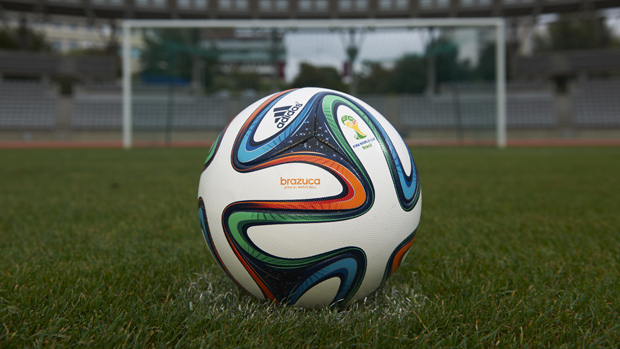Introducing the Brazuca: the world’s most tested football
A week before the new World Cup ball was revealed, FFT’s Andrew Murray travelled to adidas HQ for a kickabout and to find out what all the fuss is about

Ball ground zero
There’s plenty new in the Brazuca – Brazilian slang for the local way of life – but the starting point was the technology in the Tango used at Euro 2012 and the current Champions League ball. “My mission is quite simple: to create products that are best for the athlete and the game,” Matthias Mecking, adidas business unit director for football hardware, tells FFT. “Many said these were the best balls out there, so we took these as the base. The whole interior is taken almost one-to-one from these ball as are the pimples on the exterior, which maximise foot-ball-contact.”
Clever panelling
It’s the Brazuca’s outer shell where the magic happens, however. The carcass is made of only six inter-locking panels, all the same shape, which are thermally bonded together. “The outer shell is like a big 3D puzzle,” says Mecking, “and because there are the fewest elements ever on a football of only one design, you make fewer mistakes. It’s welded together to eliminate human error by hand-stitching. It’s more accurate and more consistent.” Though FFT did hit a few wayward shots in testing, one howitzer straight into the top corner did feel especially brilliant.
The design
Like the name, inspiration has come from host country Brazil. The yellow and green of the country’s flag, as well as the 2014 World Cup logo, have been incorporated into the design, while the meandering splashes of colour symbolise the wish bands that many Brazilians wear to bring them good luck. “The design really captures the emotion and desire for football in Brazil,” says Mecking. “Even the stars represent one of the country’s important constellations, as well as recognising Brazil as multi-time winners.”
FIFA-approved test
But for all the talk of butyl bladders, thermal bonding and pimple exteriors, the Brazuca wouldn’t have got far without passing the world governing body’s basic criteria, the minimum to be used in official competition. Stepping inside a borderline hermetically sealed lab, machines test the ball’s weight, its roundness, how it bounces at 20C and 5C, water absorption and durability. “As an example,” lab manager Oliver Dittmann tells FFT, “the durability is measured by using a machine to fire a ball at a wall continuously 2,000 times and check how much pressure and roundness it’s lost.” FFT is feeling a bit dizzy from all this science.
Even more lab scrutiny
But the adidas boffins aren’t content with making a World Cup football that only meets the most basic requirements. Their internal tests are yet more rigorous, the Brazuca’s durability test ratcheted up to 3,500 bangs into a wall and how it bounces at -5C. Best of all is how little weight it gains in wet conditions: just 0.2 per cent, instead of the FIFA standard 10 per cent. “Water absorption is the sexiest test, isn’t it!” laughs football innovation director Antonio Zea. “I once headed a wet 1982 Tango ball and I swear I nearly got a concussion! The thermal bonding process seals the ball to make it virtually waterproof.” They even tested the ball’s aerodynamics in a wind tunnel. Now, that’s progress.
Bring out the robot!
There’s only so much lab analysis you can do with a ball. Ultimately, it’s got to be kicked, but how if you want to hit hundreds of perfect shots in a row to test the flight path’s accuracy, speed and swerve? Answer: build a robotic leg. “It hits shots in a perfectly reproducible way,” says Mecking. “We have frame-by-frame cameras that pick up the ball’s flight path to measure at what point the Brazuca deviates from the norm. We can see, down to the millimetre how much and at what point the ball deviates.” It can even change the boot that does the kicking. Predator or f50? The agony of choice.
Player testing
“This is where we’ve spent the most energy,” says Mecking of the two-and-a-half years, 10 countries, 600 players (30 per cent non-Adidas contracted) it’s taken to get to this point. “This year’s Under-20 World Cup in Turkey was played with a disguised version of the Brazuca, the first time a ball has ever been trialled in a live tournament. It was also used in February’s Sweden v Brazil friendly. Most importantly, players say it’s fair.” England captain Steven Gerrard certainly agrees: “The sign of a good ball is when no-one really talks about it, and I don’t think anyone will have anything bad to say about Brazuca.”
Get FourFourTwo Newsletter
The best features, fun and footballing quizzes, straight to your inbox every week.
Problems with Jabulani
After coming in for criticism at the last World Cup, the pressure has been on to deliver the perfect ball for Brazil 2014. “We’re still proud of the Jabulani, at the time it was technically the most advanced ball we’d ever produced,” says Mecking. “We wanted keepers to say the Brazuca was fair: Pepe Reina and Rene Adler came to adidas HQ to test it on a special keepers day. It all sounds nice, in theory, but I wouldn’t be talking about it if I didn’t believe in it. The Brazuca is by far the most tested ball we’ve ever produced.” And, if FFT says so itself from a day’s testing, it shows, too...
